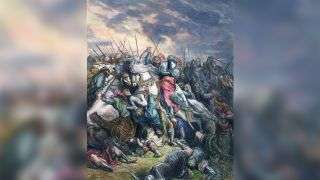
Richard the Lionhearted leads his Crusaders in battle against the Muslims at Arsuf.
An archaeologist in Israel has located one of the Third Crusade’s key battlefields — the spot where Richard I of England, also known as Richard the Lionheart, and his troops defeated Muslim forces.
His victory was short-lived. Although King Richard’s Christian forces won the fight, known as the Battle of Arsuf, they ultimately lost the Third Crusade to the Muslims, who held onto the Holy Land, said study researcher Rafael Lewis, an associate researcher at the Zinman Institute of Archaeology at the University of Haifa in Israel.
“Unfortunately for the Crusaders, even though they won the Battle of Arsuf, they didn’t win it decisively enough,” Lewis told Live Science. “The Muslim forces were still standing on their feet, and they were able to skirmish the Crusader army for another year. This all ended with a treaty, which allowed Richard and his men to go up to Jerusalem to fulfill their pilgrimage to the city, but they didn’t capture it.”
During the Third Crusade (1189 to 1192), Richard the Lionheart and other Christian forces went to recapture Jerusalem from the sultan Saladin (the Western name for Salah al-Din ibn Ayyub), who had united the Muslim world when he captured the Holy City from the Christians. After the Muslim-held coastal city of Acre fell to the Christians, Richard I opted to take his troops to Jaffa, so they could capture its port — a move that would help the Crusaders secure provisions and possible reinforcements for the planned siege of Jerusalem, Lewis wrote in the study. Over the next 17 days, the troops marched along the coast until they reached Arsuf, where Saladin’s forces were waiting.
Both the Crusaders and the Muslims were hoping for a decisive result, with one side losing so badly that the war would have a clear winner, Lewis said. But after making three charges against Saladin’s men, the Crusaders defeated, but didn’t shatter, Saladin’s forces.
Image 1 of 4Image 2 of 4Image 3 of 4Image 4 of 4Finding the battlefield
Other historians have tried to pinpoint the battle’s location, which they knew happened north of modern-day Tel Aviv. But Lewis said he is the first to find the exact location of the Sept. 7, 1191 battle.
The location was described in May in the Monograph Series of the Sonia and Marco Nadler Institute of Archaeology.
Lewis knew the battle began near the village of Arsuf, “but we didn’t know exactly where,” so he began “going back in time” by combing through documents such as aerial photography, historical photographs and written records kept by people passing through Arsuf. Lewis also examined the shape of the landscape and archaeological accounts, until he had a good idea of where the battlefield might be. Then, he went there in person to search for battle artifacts.
In a limited metal-detector survey of the site, Lewis found an iron plate (possibly from a helmet), iron horse harness fittings, and a violin key horseshoe nail, a tool used in England and France during the 12th and 13th centuries, he said.
Lewis also found two arrowheads: one designed to pierce armor (in 12th century battles, men wore four layers of protective clothing and armor, Lewis noted) and another that was flatter, like a disc, and designed to target horses, so that the animals would be wounded and rear up, throwing off their riders.
RELATED CONTENT
—Photos: Parasite eggs found hiding in 500-year-old Jerusalem latrine
—Cracking codices: 10 of the most mysterious ancient manuscripts
—Image gallery: Medieval art tells a tale
Written sources say the Battle of Arsuf took place near an oak woodland, and detail how the Crusaders stopped at the edge of the forest after the charge. That forest isn’t there anymore (it was cut down by the beginning of the 20th century), but after Lewis consulted historical texts, maps and aerial photographs, he estimated the edge of the forest and deduced where the armies had fought, given that each charge covered roughly 820 feet (250 meters) in distance.
The new research “gives us a fairly sound idea of where the battle took place,” Adrian Boas, an archaeologist at Haifa University who specializes in the Crusades and was not involved with the study, told Haaretz.
In an interesting historical note, when Richard the Lionheart died in 1199, his heart was preserved in a crystal box containing mercury, mint, frankincense and several sweet-smelling plants, Live Science previously reported. Meanwhile, Saladin died in 1193, possibly of typhoid, according to doctors who retroactively diagnosed him based on historical records, Live Science reported in 2018.
Sourse: www.livescience.com





